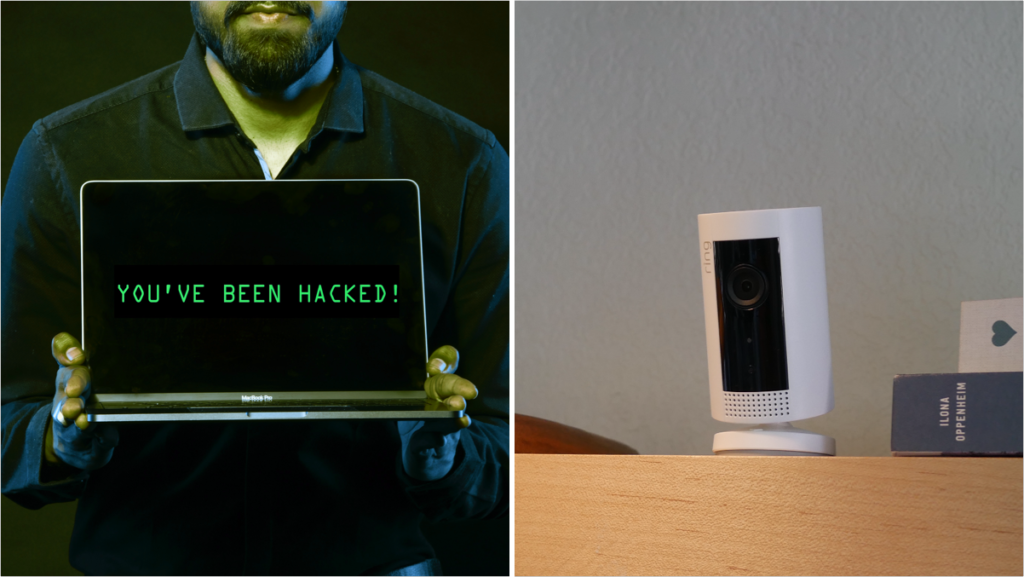4 Home Tech Hacking Horror Stories and How They Could Have Been Prevented (+ Videos)
By Rob,
When you buy through our links, we may earn an affiliate commission.
With the ever increasing availability of smart home devices many homeowners have invested in securing their properties with cameras, alarms, security lights, smart locks etc. While this may help prevent physical unwanted intruders, it can often lead to a more remote vulnerability that is somewhat more difficult to prevent.
1 – The Terrified Ring Camera Owners vs Amazon 2020
Following cases being filed over a number of years, a US law firm filed a class action lawsuit detailing dozens of Ring camera owners who had had their devices hacked, and some of the stories that came to light were horrifying:
- One Ring user was addressed via his living room camera speaker one evening and was asked “what are you watching?”
- Another owner reported that one of their cameras began playing “Tiptoe Through The Tulips” from the horror film “Insidious”. When it was investigated by their 8 year old daughter, the song stopped and a voice said “Hello there”
- One couple had installed a Ring camera in a room at their elderly mother’s retirement home that was targeted. She was sexually harassed and, at one point, told, “You will die tonight”. The ordeal was so terrifying that the elderly lady was forced to move back in with her family.
- Another Hacker managed to gain access to a bedroom camera of an 8-year-old girl and, claiming to be Santa Claus, began encouraging her to smash things in her room.
In a lot of these cases, Ring was largely unhelpful when these breaches were reported. Often doing very little or blaming the user for the security breach.
In reality, the 2019 data breach that Ring suffered was more than likely the cause.
2 – Hackers Turn Up The Heat
It’s not just a camera’s connection to the outside world that can leave you vulnerable. In 2019 hackers gained access to this Google Nest customer’s smart thermostat. The family became suspicious when they began sweltering in the 90 degree temperature being set by someone outside of the home.
3 – Baby Monitor Hacked
Unfortunately, it’s often the most vulnerable that can become targets for hacking. While many baby monitors offer an out the box solution for keeping an eye on your new arrival, securing this feed often gets neglected in favor of convenience.
4 – Thieves Jam Ring Camera
It’s not just remote attacks you need to be worried about. Thieves are getting smarter too, and with the rise in popularity of smart home security, methods to prevent getting caught on camera are also being developed.
How Can I Prevent My Home From Being Hacked.
Most of us are subject to IT security training in our current employment, no matter how little technology is actually used in performing the job itself. Like me you’ve probably skipped through these videos, but the basics they cover are now fundamental to ensuring your ever smartening home isn’t compromised.
1. Your Network
This is probably the most important step to securing your smart devices. Most hackers aren’t gaining access to your smart fridge in the hope they can learn what you had for dinner. It’s merely acting as a conduit onto your network where they can steal more valuable data.
Install security software on devices capable of it, keep your firewall on and maybe consider a network firewall device that monitors and can warn you about unsolicited traffic. If you have devices you’re concerned lack appropriate security levels, consider putting them on a separate SSID (if your router is capable).
2. Passwords
Never leave a password for any device or account that accesses your home network as the manufacturers default. Ensure you have different passwords for different devices so that one data leak doesn’t take down your entire home. Change passwords regularly, particularly those that are stored by larger companies that are prone to attacks.
3. Software Updates
Ensure the software on your various smart home devices are on the latest available version. Hardware vendors frequently release security patches as new threats are discovered. Turn on automatic updates where possible and regularly check those devices that need manual updates.
4. Two Factor Authentication
If a provider or device offers two factor authentication then it’s worth opting in to it. This will be along the lines of using face ID on an iphone to access your account along with your password, or sending you a text message containing a code to enter. It may seem like extra effort but it makes it very difficult for someone to target you for an attack.
5. End to End Encryption (E2EE)
Opt for a camera (and any other compatible device) with end to end encryption available. This will prevent camera passwords and feeds being hacked while in transit. Make sure it’s enabled and set up correctly.
Conclusion
Highly-skilled, amoral and sadistic hackers do make for entertaining print. However, while the reality probably isn’t as terrifying as many publications make out, IT security within our homes has never been more prevalent and certainly should not be ignored.
Even the most mundane of smart devices within the home can be targeted (my washing machine has access to my Wi-Fi network) and, as more of our day to day lives become connected to the internet, the need for our knowledge of how to secure ourselves against hackers increases.
Luckily, at SmartHomeStarter, we have you covered.

